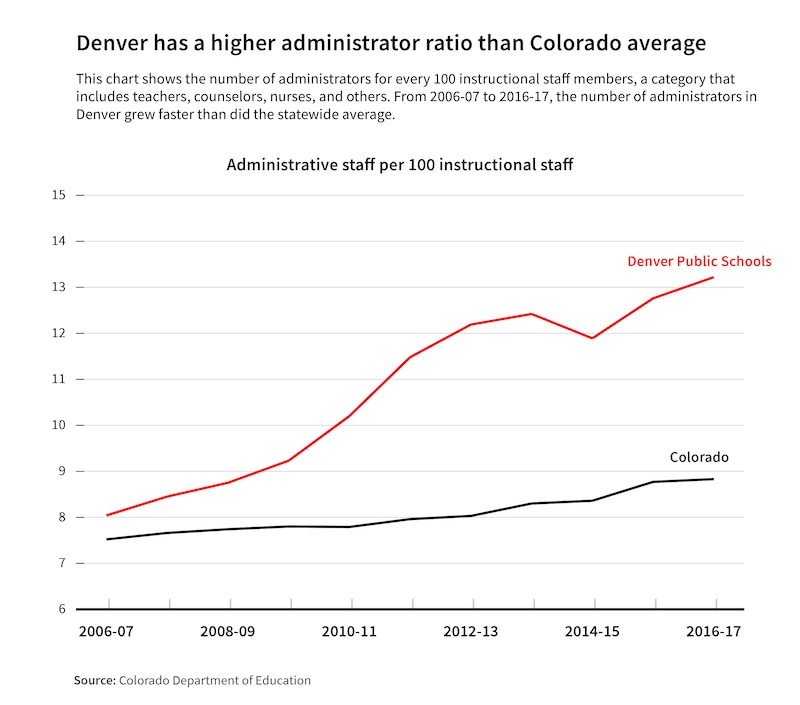Compared with the statewide average, the Denver school district is top-heavy with administration.
In the 2016-17 school year, Denver had one administrator for every 7.5 instructional staff members, a category that includes teachers, librarians, nurses, and others. The statewide average was one administrator for every 11.3 instructional staff members.
Those figures are based on a Chalkbeat analysis of the most recent data available from the Colorado Department of Education.
While Denver Public Schools has always had more administrators than the statewide average, the data show the 93,000-student district has gotten more top-heavy over time.
One implication of having more administrators is financial. The more money a district spends on administrators, who tend to earn higher salaries, the less money it has to pay teachers.
Denver Public Schools is currently negotiating teacher pay with the Denver teachers union. The stakes are high: The union has threatened to strike if an agreement isn’t reached by Jan. 18.
The union, called the Denver Classroom Teachers Association, is pushing the district to invest a lot more money into teacher salaries. New Superintendent Susana Cordova, a former teacher, is open to increasing the district’s investment — and to funding it by cutting administrators. She has publicly said the district’s central office, where many administrators work, is too big.
“We have too many priorities, too many people working on those priorities, and not enough impact coming out of that,” Cordova told union negotiators at an all-day bargaining session Tuesday. “I am 100 percent committed to right-sizing what the central office looks like.”
The district’s latest offer would invest $17 million more into teacher pay, which still falls short of the union’s demands. Officials have said $7 million would come from cuts to the central office.
“They will be difficult cuts to make,” Cordova said. “Nobody is sitting around doing nothing.”
But, she added, “My personal perspective is there are higher-value things we can be doing with that money,” including raising salaries and giving teachers more predictability in their paychecks. The union has complained the current system focuses too much on one-time bonuses.
A closer look at the numbers
Denver had 949 administrators and 7,183 instructional staff members in the 2016-17 school year, according to Colorado Department of Education data. That’s a ratio of one administrator for every 7.5 instructional staff members.
The administrators included the superintendent, dozens of executive directors, and hundreds of principals and assistant principals. The instructional staff members included teachers, deans, curriculum specialists, counselors, psychologists, social workers, nurses, and others.
Statewide, there were 5,447 administrators and 61,675 instructional staff members in 2016-17. That’s a ratio of one administrator for every 11.3 instructional staff members.
Denver Public Schools is the largest school district in Colorado. In 2016-17, the Denver district was serving about 10 percent of the more than 900,000 students in Colorado.
But that same year, Denver had 17 percent of school district administrators in the state.
Denver’s ratio of administrators to students is also significantly higher than the statewide average. In 2016-17, Denver had one administrator for every 96 students. The statewide average was one administrator for every 166 students.

However, the statewide average includes Denver, which has an outsize impact on that average because of its size. Excluding Denver from state totals, the statewide average for 2016-17 was one administrator for every 180 students. Denver’s ratio is almost twice that.
There’s a significant caveat to the numbers, though: They include charter schools. That means some of the 949 administrators who worked in Denver schools in 2016-17 were not employees of the district, but rather worked for charter schools.
Charter schools are publicly funded but independently run. Denver Public Schools has no control over how many administrators a charter school hires.
But the district does have some control over how many charter schools exist in Denver. Over the past two decades, the Denver school board has approved more charter schools than any other district in the state. This year, 60 of Denver’s 213 schools are charters.
Why Denver has more administrators
The growth of charter schools has contributed to another phenomenon: the rising number of schools in Denver. More schools means more administration.
But charters haven’t been the only factor. Other district decisions have played a role, too. For example, in 2010, the Denver school board voted to close Montbello High School and replace it with three smaller schools, all of which have their own principals and assistant principals. Test scores at Montbello were dismal, and the board hoped the new schools would serve students better. Whether that’s happened remains a subject of heated debate.
Denver district officials believe small schools serve students well. “To make sure kids have ample choice on where they want to go, and to make sure we have quality schools, we have decided to have smaller schools,” said Mark Ferrandino, the district’s chief financial officer.
He pointed to the district’s “multiple pathways” schools as a good example. These schools serve students who have struggled to earn credits at traditional high schools or previously dropped out. Ferrandino said providing students with alternative learning environments has helped the district increase its graduation rate and reduce its dropout rate.
“Our ‘pathways’ schools, those are a small number of kids, but they still need a principal — and that impacts the ratio of administrators to teachers,” he said.
While it’s true that Denver has added more principals over the years, they haven’t been the main driver of the growth in administration. Rather, the data show the categories that grew the most from 2006 to 2016 were assistant principals and district-level directors.
District officials said those directors are working on initiatives that help students, such as providing extra funding, training, and guidance to low-performing schools — a strategy that a recent study found is working to boost student test scores.
What’s more, not all administrators’ salaries come out of the district’s coffers, officials said. According to the district, 72 central office positions are funded by grants. Officials also argued that Denver spends just 4 percent of its $1 billion budget on central office costs.
Still, Ferrandino said the district is committed to reducing those costs even further.
Corey Kern, deputy executive director of the Denver Classroom Teachers Association, said top-heavy administration is a common concern among teachers — and one that teachers have brought up countless times during salary negotiations.
“They see this explosion of administration in their own buildings that they don’t understand,” Kern said. “Every time we have a high school with seven or eight (assistant principals) in it instead of teachers, that’s more of that school’s budget that’s not in the classroom.”
Growing gaps
Denver Public Schools hasn’t always been this top heavy. The Department of Education data show a significant change over time.
One easy way to look at it is by calculating the number of administrators per 100 instructional staff members. In the 2006-07 school year, Denver had eight administrators for every 100 instructional staff members. By 2016-17, the number of administrators had jumped to about 13 per 100 instructional staff members.
To be fair, the statewide average increased, too — but not as much. Colorado’s numbers went from 7.5 administrators to about 9 administrators for every 100 instructional staff members.
Colorado’s second-largest district, Jeffco Public Schools, hasn’t seen nearly as much change. And whereas Denver has more administrators than average, Jeffco actually has fewer.
Administrators in Denver also earn higher average salaries than administrators statewide. In 2016-17, the average administrator salary in Colorado was $87,416. In Denver, the average administrator salary was $108,470. In Jeffco, it was $102,484.
Denver officials argue that part of the reason for district’s administrative growth is that the number of students increased 25 percent from 2006 to 2016.
While that’s true, the number of administrators in Denver grew by 140 percent in that same time period. The number of teachers and other instructional staff increased by just 46 percent.

